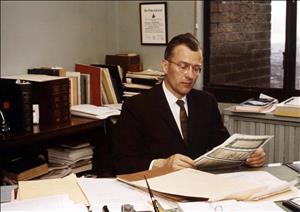In the excerpt from his memoirs, famed Seattle civic activist Jim Ellis (1921-2019) writes about friend and civic leader Jack Henry and his wife Jean. As Ellis writes, "Jack had been a friend since my earliest Municipal League days. I knew him to be a respected bank loan officer with absolute integrity. Jack was a dedicated civic activist and a Board Member of the Municipal League. He helped found the Bellevue Sewer District in the 1950s. His leadership in the months leading up to the creation of Metro had become legendary."
A Banker's Banker and a Valued Friendship
John Frazier "Jack" Henry was born in Seattle on March 10, 1908. Raised and educated in Spokane and Seattle, he attended the University of Washington in the early 1930s during the depths of the Great Depression. He left the University in 1934 to accept what was then a rare opportunity for full-time employment at Pacific National Bank in Seattle. Jack later attended a part-time banking program at the University but never attained his formal degree.
At about this same time, Jack began courting Jean McLaren, who was also attending the university. They met in a fencing class at the Washington Athletic Club. Jean and Jack were married in May 1934 on Mercer Island. Their honeymoon was a long drive in a Model ‘A’ Ford through several Southwest states. While exploring the Santa Fe and Taos areas, they collected traditional Pueblo pottery and fell in love with the region. It was during this trip that they discovered their mutual interest in First Nations people and their artifacts.
Jean McLaren was born December 17, 1912, in Hood River, Oregon. Her mother died when Jean was a young girl and soon after her father moved Jean and her brother Archie to Mercer Island. Jean took the steamer Dawn across the lake and then rode the Yesler trolley to Broadway Grade School and eventually to Garfield High School, where she graduated in 1930.
John and Jean’s first home was a cottage on Bainbridge Island, rented from friends. They soon bought a small home near Rolling Bay. Jean worked as a kindergarten teacher and their two daughters were born on Bainbridge Island, Jeannie in 1939 and Elizabeth in 1942. John continued working as a banker, commuting from Bainbridge to downtown Seattle. His years of experience as a bank loan officer and later as a manager of other loan officers gave him a unique ability to assess the capacity of King County property owners to bear the burdens of property tax debt in hard times. By 1966, he was recognized in the Seattle banking community as "a banker’s banker." He was cautious in approving affordable mortgage-debt payment schedules. He understood that property-tax obligations and mortgage loans should both fit within a taxpayer’s income and cashable reserves.
In 1946, John and Jean moved from Bainbridge Island to South Seattle and shortly thereafter to Bellevue, where they built a home designed by architect Fred Bassetti in the Vue Crest neighborhood. John continued working as a banker at Pacific National Bank, which became First Interstate Bank and ultimately Wells Fargo Bank. He retired as a senior vice president in 1973.
Jack and Jean were ardent outdoor enthusiasts, knowledgeable about gardening and Northwest plants, and later became very knowledgeable about Pacific Northwest native cultures. The Henrys participated in several UW anthropological digs along the Columbia River and Jack spent one three-week vacation digging for artifacts on Fountain Bar and found a fabulous small collection of arrow heads. In the late 1930s, Jack and Jean bought a Willits Canoe from the Willits Brothers for $35 and canoed local saltwater areas, and even to remote Indian villages off the Inside Passage of British Columbia. In 1936, they canoed up Johnstone Strait to Alert Bay. Jack also canoed with his friend Art Williams in 1946 to the end of the 60-mile-long Night Inlet in British Columbia and back.
In their trips to early Indian village sites, they documented the sites with pictures and created a valuable record of First Nation villages, many of which have disappeared in the jungle of Northwest plant growth. Jack demonstrated courage even into his 80s, when he took a small outboard motorboat by himself through the dangerous West Coast waters of Vancouver Island to visit Indian villages. From each post office along his way, Jack thoughtfully mailed me an envelope with a treasured stamp collector’s postmark.
As their daughters grew, the Henry family went camping and hiking in the Cascade Mountains in Washington and in Eastern Oregon, and in the Olympics in Washington’s coastal area. He was a naturally gifted craftsman who began carving copies of Native American masks, which he borrowed from the museum to use as models. He sold his beautiful masks and eventually Erna Günter, head of the Anthropology Department at the University of Washington, told Jack, "You need to sign your carvings or they would be misjudged to be native originals."

